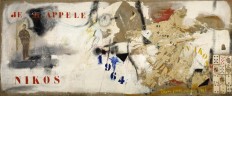TITLEJe m’ appele Nikos
MEASUREMENTS (cm)Height : 90
Width : 218
USED MATERIALSMixed media
SIGNATURESigned
CHRONOLOGY
AUTHENTICITY CHECKNot checked

Literature:
P. Restany, NIKOS, Kastaniotis ed., Athens 1988, p. 79 (illustrated).
H. Kambouridis, The Platonism of a Barbarian, Municipal Gallery, Thessaloniki 1988 (illustrated p.57, fig. 77).
Nikos Kessanlis, Grecia-Biennale di Venezia 1988, Greek Ministry of Culture, Athens 1988 (illustrated).
Incessantly creative and cunning, Nikos Kessanlis, known to the international art scene as Nikos and celebrated as a leading figure of Greek modernism, devoted his life to a constant re-invention of ideas and forms. In 1964, the year he painted his captivating autobiographical piece Je mappelle Nikos, he was in Paris, caught up in the aims and aspirations of the postwar avant-garde.
In Je mappelle Nikos, which preludes the artists decisive turn towards photographic reproduction techniques1, he works his surface over with paint in the characteristic, spontaneous gestural language of Action Painting, but his painterly expressiveness is tamed by the incorporation of alien matter. Like Jasper Johns, he revives the cubist use of letters and numbers to tie his painting simultaneously to the realities of both the flat canvas and the world outside. Drawing upon Robert Rauschenbergs famous combine paintings, he introduces a freedom of surface and a combination of found objects, such as a photographic self-portrait on the left and twelve playing cards pasted on the lower right, but with a brilliance of colour and compositional wisdom all his own.
By objectifying and depersonalising the abstract expressionist gesture, Kessanlis manages to keep the dialogue between the sense of art and everyday reality open and unresolved. This method of creating an artistic structure based on the collaboration of different materials recalls Rauschenbergs oft-quoted statement that became a slogan of the new radical realism in the 1960s: Painting relates to both art and life. I try to act in the gap between the two.
1. 1964 was a good year for me, possibly the most important one of my life. I was young, I had money, my name was known
And during this good period of my life, I found a new direction for my work: photography. (as quoted in Nikos Kessanlis, ed. G. Tzirtzilakis [in Greek], Athens 1998, p. 513).